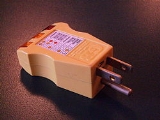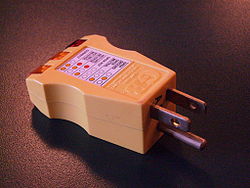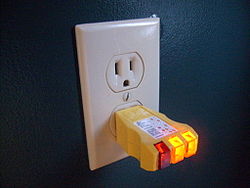
Receptacle tester
Encyclopedia

Domestic AC power plugs and sockets
AC power plugs and sockets are devices for removably connecting electrically operated devices to the power supply. Electrical plugs and sockets differ by country in rating, shape, size and type of connectors...
is wired properly. The tester itself is small device which looks like the "plug in" end of a power cord, with several lights on it rather than an attached cord. Although a multimeter
Multimeter
A multimeter or a multitester, also known as a VOM , is an electronic measuring instrument that combines several measurement functions in one unit. A typical multimeter may include features such as the ability to measure voltage, current and resistance...
could be used to perform a series of tests which would give the same results, an outlet tester can perform the entire array of tests by simply plugging the device into the outlet once and observing the state of the lights. The tester performs several tests at once but the tests themselves essentially fall into two categories: tests which determine that the outlet actually functions and tests which determine that the outlet is properly wired for safe operation.
Functionality
The most basic job of the outlet tester is to verify that the outlet actually provides power to a device plugged into it. In order for an AC outlet to be functional it must have, at a minimum, a live or "hot" connection to a varying electrical voltageVoltage
Voltage, otherwise known as electrical potential difference or electric tension is the difference in electric potential between two points — or the difference in electric potential energy per unit charge between two points...
, and a neutral connection to complete the circuit. If either of these is not hooked up, or is damaged in some way, then the outlet will not function at all. The voltage between these two connectors also needs to fall within a certain range for proper operation, however many outlet testers only check for the presence of voltage across the proper connectors, not the actual level of voltage, which can easily be checked with a multimeter.
Safety

Electrical wiring
Electrical wiring in general refers to insulated conductors used to carry electricity, and associated devices. This article describes general aspects of electrical wiring as used to provide power in buildings and structures, commonly referred to as building wiring. This article is intended to...
. There are two primary reasons for testing this. First, some devices must have a specific prong connected to the live connection or damage to the device could result. Second, and more importantly, if the live wire is connected but the neutral or ground wire is not, a dangerous situation could be created by preventing safety mechanisms from operating properly. Furthermore the ground wire is typically attached to the case of an electrical device as a safety precaution to carry away current if the insulation on the wires is damaged and the case becomes charged. Although this is an important safety feature on many devices, if the outlet is improperly wired with the ground plug connected to the live wire the safety mechanism has the opposite effect and charges the outside of the device creating the potential for an electric shock
Electric shock
Electric Shock of a body with any source of electricity that causes a sufficient current through the skin, muscles or hair. Typically, the expression is used to denote an unwanted exposure to electricity, hence the effects are considered undesirable....
for anyone touching the device.
Note also that simple three light testers cannot detect two potentially serious house wiring errors: (1) neutral and ground reversed at the receptacle. (2) a "bootleg" ground, where the neutral and ground pins have been connected together at the receptacle. (Done by someone to attempt to fool the three light tester, typically if 3-prong outlets have been retrofitted to an old house with only two physical wires in the conduit.)
However by using the receptacle tester first, then a multimeter, the these two errors can be detected: With the meter, look for low (but not zero) resistance and volts between neutral and ground. (Zero ohms is a sure sign of a bootleg job.) For the neutral-ground reversal test, next put some load on the same outlet circuit (e.g. a 100w incandescent lamp plugged into the other socket of the outlet), the meter should show a higher voltage between hot and ground, than between hot and neutral. This is because of the voltage drop due to the load. If it is the reverse situation, then you likely have a receptacle with neutral and ground reversed.
See also
- Polarized plugs

